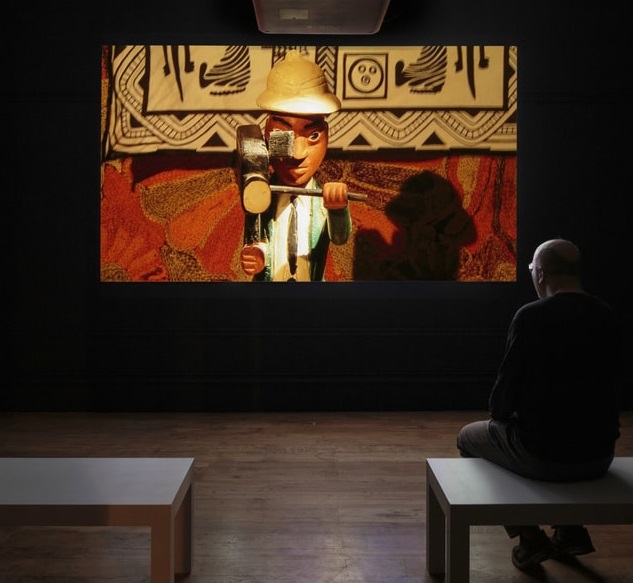


Installation view of Still Moving: The films and photographs of Ulrike Ottinger, The Hunterian, University of Glasgow (20.4.18-29.7.18). Photography by Ruth Clark. All works copyright of the artist.
Ulrike Oettinger has been one of the most enduring of filmmakers to emerge from the New German Cinema Movement in the 1960s and 1970s. Her first solo-show in the UK Still Moving at The Hunterian brings together photographs, short films and personal archival materials from the remarkable oeuvre of the 78 year old artist. Central to Oettinger’s work is a theatrical mediation on identity and difference, particularly in relation to gender, sexual orientation and power. Her spectacular non-linear narratives often mix ethnographic documentary with fiction and fantasy and in many of her works, the queer or marginalised body takes centre stage.
For her films, Oettinger carries out an extensive pre-production research process that manifests itself in photographs and sketches collaged into notebooks that are on display in vitrines in the gallery space.
A frequent traveller to remote places in Asia, the South Seas and Eastern Europe, her 1989 film Johanna d’Arc of Mongolia was the first feature film to be shot in Mongolia by a woman. It tells the fictive story of a band of European women who were kidnapped by a band of Mongolian female warriors. The European women spend a summer as captives in a nomadic tent village, where they learn the rituals of Mongolian hospitality and kinship. The film’s photographic analogues are on display in Still Moving. They reveal Oettinger’s critique of the dominant white, often male, ethnographic gaze by creating unexpected encounters between carnivalesque fictive performance and ethnographic documentary film.
The eight and a half hour long documentary TAIGA (1991/92), which brought Oettinger to Outer Mongolia, is also represented photographically in the exhibition. Like many of her filmic and photographic travel journals, it reveals her impressive eye for detail and respect for the individuals she meets on her journeys.
Oettinger, who has been based in Berlin since 1973, often uses her adoptive home as a backdrop in her work. In the so-called ‘Berlin Trilogy’ of Ticket of no return (1979), Freak Orlando (1981) and Dorian Gray in the Mirror of the Yellow Press (1984) she references iconic modernist works, for example Oscar Wilde’s Dorian Gray. However, in Oettinger’s film the figure of Dorian is portrayed androgynously by actress, model and artist Veruschka von Lehndorff.
While the 'Berlin Triology' and Johanna D’Arc of Mongolia were shown in a special screening program to accompany the exhibition during this year’s Glasgow International Festival of Visual Art, three of her shorter moving image works are on display in the exhibition itself. Among them are Superbia – The Pride (1986), commissioned by the German public TV channel ZDF for the series Seven Deadly Sins and produced by well-known female film makers such as Chantal Akerman or Valie Export and others. The film presents the sin of pride through an extravagant/flamboyant allegorical procession, intercut with images of marches, ticker-tape parades and military reviews.
The film Still Moving (2009) assembles and revives ethnographica Oettinger inherited from her father’s Africanist collection, juxtaposing them with objects from her own collections and photographs that she took in the 1970s. The film ends with a rediscovered fragment of a Super-8 film taken at the 80th birthday party of Lil Picard, a performance artist, and critic who was friends with Andy Warhol. This ‘Wunderkammer’ like presentation of people, pictures and objects in a non-hierarchical order is a reflection of the artist’s memory itself. She has stated: ‘My archive of objects is equal to the no less real archive of my memory. They animate each other and bring forth ever new and unexpected images and ideas. It is as if one were watching, as it takes shape, the play of thinking with its infinite interconnections.’
Overall, the visual power and intensity of Ulrike Oettinger’s extravagant and complex narratives play with our desire to look at the unusual or The Other. Oettinger refuses to present us with clichés or stereotypes but rather offers us a more differentiated, at times unsettling view of the world. The unexpected juxtapositions between different artist genres and the thought-provoking encounters with marginalised bodies and cultures in both her filmic and photographic practise make this exhibition an unforgettable experience and definitively a highlight of this year’s Glasgow International.
Christine Takengny
Curator
The Hunterian, University of Glasgow, University Avenue, Glasgow G12 8QQ. Open Tuesday - Saturday, 10.00 - 17.00, Sundays 10.00 - 16.00. Exhibition continues until 29 July 2018. www.gla.ac.uk/hunterian
Artist Biography
Having made Pop Art paintings and objects while living in Paris from 1962-68, Ottinger returned to her native Germany and in the early 1970s. Amongst Ottinger’s most notable early feature-length films are Madame X—An Absolute Ruler (1977) and the “Berlin trilogy” of Ticket Of No Return (1979), Freak Orlando (1981) and Dorian Gray In The Mirror Of The Yellow Press (1984). A series of quasi-ethnographic documentaries followed, including China. The Arts – The People (1985), Johanna D’arc Of Mongolia (1989), the eight-hour Taiga (1992). Subsequent projects include films applying an ethnographic lens to Ottinger’s own culture, such as Countdown (1990), and Prater (2007), and further epic travelogues, including in 2016 Chamisso's Shadow, a four-part, eleven-and-a-half-hour film filmed around the Bering Strait, which was awarded "Best Documentary 2016" by the German Film Critics Association. Ottinger received the Hannah Hoch Prize in 2011.
Solo exhibitions include: Ulrike Ottinger: Chamisso’s Schatten, Galerie Johanna BreedePhotokunst, Berlin (2015); Ulrike Ottinger: Floating Food,Haus der Kulturen der Welt, Berlin, Germany (2011);Hannah-Höch-Prize: Ulrike Ottinger,n.b.k., Berlin, Germany (2011), Bild Archive, Witte-de-With Museum, Rotterdam (2004).
Group exhibitions include: Still (the) Barbarians, EVA International, Limerick, Ireland (2016); The World Goes Pop, Tate Modern, London (2015) Burning Down the House, the 10th Gwangju Biennale, Korea (2014); Documenta 11, Kassel, Germany (2002).